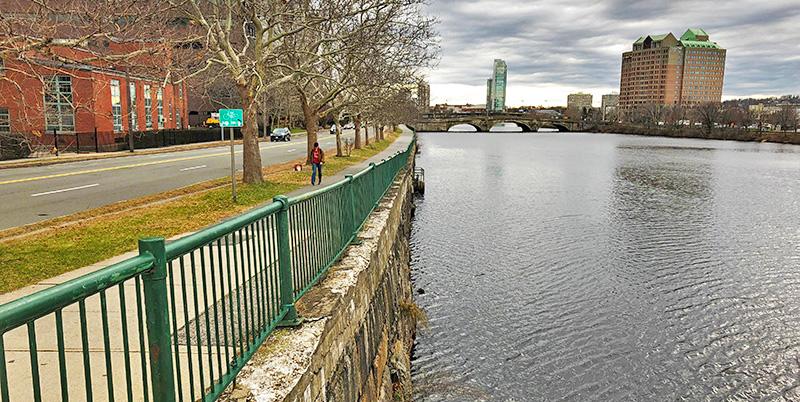Speak Up For a Safer Memorial Drive That Puts People First
Plans to overhaul Memorial Drive, between the BU Bridge and Eliot Bridge, are moving along — and next Tuesday is your first chance to weigh in on the initial concept designs.
Memorial Drive Greenway Improvements Phase III, Public Meeting
Tuesday, June 25 // 6:30 – 8:30 p.m.
Dr. Martin Luther King, Jr. School Cafeteria
102 Putnam Avenue, Cambridge, MA 02139
(enter from Kinnaird Street or Magee Street)

Prior to Tuesday’s meeting, the Department of Conservation & Recreation (DCR) collected feedback from the public online and at a listening session in April. We know that during this session many of you supported changes to improve the safety of people who bike. (Thank you to everyone who participated to date!) However, we don’t yet know which of those ideas, if any, will be included in the initial plans presented next week.
This is an extremely important opportunity to shape the future of travel and recreation along the Charles River, as this project covers not only the road itself, but the neighboring greenway and bike path, as well as the dangerous entrances/exits to bridges across the river. Don’t miss your chance to comment on these conceptual designs before DCR sets plans in stone!
Here’s what we’re asking for as part of the Memorial Drive Alliance (Cambridge Bike Safety, LivableStreets Alliance and area-residents), and what we encourage you to include as well if they resonate with you:
- Separate bike and pedestrian paths along entire route of Memorial Drive on both sides of the street. On the river side the pedestrian path should be no less than 12 feet wide, and bike path should be no less than 14 feet wide to accommodate heavy bike traffic going both directions along the path. Each path should be clearly marked with painted surface and signage – as well as a commitment from DCR to maintain these paths seasonally.
- Minimize loss of healthy trees and shoreline vegetation, particularly the health of the 100-year old sycamores must be preserved and enhanced. Plant new trees wherever possible so that the number of caliper inches is immediately a net positive upon completion. Tree planting vendors should be held responsible for survival of trees during first 4 years of planting. If cycle tracks needs to go on the road in order to retain trees, they should be physically separated from cars.
- Reduce memorial drive to two lanes of opposing traffic with exceptions at critical turning intersections.
- Eliminate right hand turn option for eastbound traffic onto to Western Ave Bridge. There is no reason that cars cannot simply use the JFK bridge or Eliot St. Bridge for this route to Mass. Pike.
- Safety improvements at the intersections of River Street, Western Ave, JFK Street, the Eliot Bridge area, and all entrances/exits to parking for Magazine Beach Park. These improvements should include, wherever applicable: updated pedestrian and bicycle crossing signals – that reflect the amount of traffic along these routes, bright green paint to demarcate the crossing area, raised sidewalk boundaries, distinct collection areas for pedestrians and cyclists, and any other traffic calming features that will make the intersections safer for all users.
- Consider changes to Memorial Drive that will lower speeds and allocate space more evenly for all types of uses, including: traffic calming features such as raised crosswalks that force slower speeds, not simply encourage them, upgraded demarcations, the elimination of one or more lanes of vehicular travel, and a reduced speed limit of 25 MPH to match the rest of the city. We are asking for raised crosswalks at the intersections of BU bridge rotary, River St., Western Ave., and JFK st.
- Improve upon the Spring 2019 “quick build” changes made to the BU Rotary area, including the installation of a permanent protected bike lane throughout the rotary with physical separation and ample demarcation. Consider the possibility of adding a dedicated bus lane or a combined bus/bike lane so that the CT2 and 47 busses can get through more easily at rush hour. These quick fixes are meant to test ideas for inclusion in the “permanent” improvements yet to come.
- Immediately match all signal phasing to the rest of the city, with concurrent walk signals, leading pedestrian intervals (LPIs) and No Turn on Red signage at all intersections.
If you can’t attend Tuesday’s meeting, you can still submit feedback online here.
There is intense interest in this project — DCR received more than 800 comments during the listening session — meaning there will be spirited debate going forward. Show up and speak up, and ensure the voices of cyclists are adequately represented in this important conversation about the future of the Charles River!

